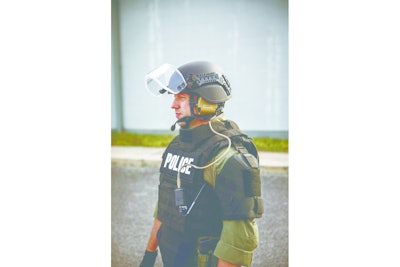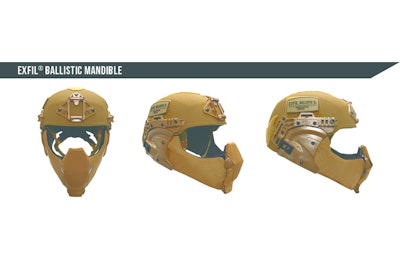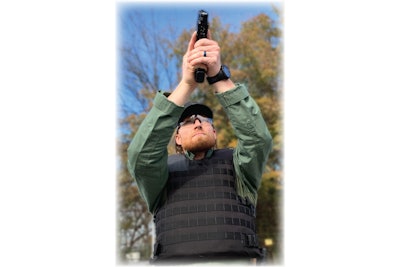While most officers who are shot at are still attacked by criminals wielding handguns, it is becoming more common for law enforcement to face bad guys with rifles, including active shooters. So there is growing demand from law enforcement agencies for hard armor.
Hard armor is currently the only option for stopping centerfire rifle rounds such as the AR-15's 5.56mm NATO and the AK-47's 7.62 x 39mm. It's also an excellent defense against high-powered handgun rounds. The downside to hard armor is that it can be heavy and uncomfortable, but thanks to new designs and materials that's changing.
Head Protection
In recent years, the ballistic helmet has become much more important in law enforcement operations. It used to be rare to have ballistic helmets in the equipment bags of patrol officers, as they were pretty much reserved for SWAT. The need for patrol officers to respond quickly and decisively to active shooters changed that and now more agencies are supplying their first responding officers with protective headwear.
Two of the leading providers of law enforcement ballistic helmets are Armor Express and Team Wendy.
 The Busch PROtective AMP-1 TP ballistic helmet from Armor Express meets the VPAM protection standard. (Photo: ArmorExpress)
The Busch PROtective AMP-1 TP ballistic helmet from Armor Express meets the VPAM protection standard. (Photo: ArmorExpress)
Armor Express is best known for its concealable body armor, but for the past few years, the company has been a major player in the ballistic helmet market through its agreement with Germany's Busch PROtective. The flagship of the Armor Express helmet line is the Busch PROtective AMP-1 TP, a lightweight composite helmet that meets Europe's VPAM ballistic protection standard, which is more stringent in its test protocol than the U.S. NIJ standard. The
AMP-1 TP features a wheel dial for size adjustment, accessory rails, and comfort padding. Armor Express supplies the AMP-1 TP to the DEA, the U.S. Marshals Service, and other agencies.
 Team Wendy’s EXFIL Ballistic Mandible shields the wearer’s face and ears with a ballistic coverage area of a little more than 72 inches. (Photo: Team Wendy)
Team Wendy’s EXFIL Ballistic Mandible shields the wearer’s face and ears with a ballistic coverage area of a little more than 72 inches. (Photo: Team Wendy)
Team Wendy recently introduced facial protection for its EXFIL Ballistic helmet. The company's new ballistic mandible when combined with the EXFIL Ballistic Visor protect the wearer's entire face. Team Wendy's EXFIL Ballistic Mandible shields the wearer's face and ears with a ballistic coverage area of a little more than 72 inches. The Ballistic Mandible weighs 1.3 pounds and is designed to let the wearer establish a natural cheek weld with his or her weapon.
Hard Body Armor
Wearable hard armor plates range in protection level from lightweight armor that works in conjunction with soft armor to protect against NIJ Level III threats to heavier, thicker armor that can protect against armor piercing rounds.
Recently, a number of manufacturers have been experimenting with new materials for stopping rifle rounds. One of these is boron carbide.
 In addition to its multi-hit survivability, the Verco Materials' armor system is flexible, which the company says makes it more comfortable. (Photo: Verco Materials)
In addition to its multi-hit survivability, the Verco Materials' armor system is flexible, which the company says makes it more comfortable. (Photo: Verco Materials)
Verco Materials is producing a unique armor system constructed of boron carbide tiles. Dr. Robert Speyer, a professor in the School of Materials Science and Engineering at Georgia Tech, says that he and his team were experimenting with high temperature boron carbide when they realized it had potential for ballistic protection. They then developed a way to produce that material into complex shapes and created "imbricated" armor. Imbricated is a fancy word for assembling things into a pattern with a partial overlap, Speyer explains.
Essentially what Verco has created is 21st century chain mail. The armor can protect wearers from a variety of high-powered threats. And Speyer says it does so much more effectively against multiple hits than ceramic armor. "If you shoot a ceramic plate, it cracks everywhere," Speyer says. "With our system, only the tile that gets hit is damaged."
The multi-hit protection of the Verco armor is enhanced by its construction. The imbricated pattern of carbon-wrapped boron carbide tiles is vacuum encapsulated into a ballistic fabric, then sewn to a ballistic fabric, and finally sealed into a waterproof cover to create the plate.
 Verco Materials' armor uses a pattern of boron carbide tiles to protect the wearer from rifle and handgun threats. (Photo: Verco Materials)
Verco Materials' armor uses a pattern of boron carbide tiles to protect the wearer from rifle and handgun threats. (Photo: Verco Materials)
In addition to its multi-hit survivability, the Verco system is different from other hard armor because it is flexible, which Speyer says makes it more comfortable to wear. "Between each tile, you can get a little bit of rocking that doesn't open up any gaps. The design ensures that all the oblique angles are covered. There are no gaps that a bullet can get into," he explains.
Verco's UrbanShield model was designed specifically for law enforcement. It's available in a shooter's cut Level III that weighs 4.9 pounds and in a 12.3-pound extended cover versions that wraps around the wearer's body. Shoulder protection is also available.
Speyer says he knows the UrbanShield is a little heavier than some of its competitors, especially in extended coverage versions, but he believes the Verco design is more comfortable and offers better protection than lighter plates. "This armor flows around the body and kind of sucks down into the body so it feels like it's part of the body. You don't feel the uncomfortable weight that you would with a [standard] plate."
Point Blank offers 16 separate models of hard armor plates under the Paraclete brand. They range in capabilities from Level IIIA (.44 Magnum) standalone, to Level III in conjunction with IIIA soft armor, to Level IV standalone. Here's a look at two of them.
The Paraclete Omega Hard Armor Plate is designed to stop Level III and special rifle threats in conjunction with soft armor. The plates are available in full-size and shooter's cut versions ranging in weight from less than a pound to nearly three pounds, depending on cut and dimensions.
The Paraclete Model 9900SA Hard Armor Plate is a standalone plate designed to stop Level IV threats, including the M855 "green tip" 5.56mm NATO and high-powered AK rounds. Paraclete's Model 9900SA is available in shooter's cut and full-size ranging in weight from 2.8 pounds to 7.7 pounds, depending on size and cut.
The Oldest Form of Armor
It can be argued that the first armor was the shield. Over the years this handheld armor has evolved from wood to metals to polymers. The goal of all this evolution was to create a shield that would block the most damage for the least weight, and the result is today's handheld bullet blockers made of lightweight polymers.
Shield technology has come a long way. So has shield design. Some of the newest shields for law enforcement even fold.
Case in point, the Aegix Swift Ballistic Shield. The Swift Ballistic Shield folds so that it can be stored behind the driver's seat of a patrol vehicle, into a motor officer's saddle bag, or tucked into a backpack for plainclothes operations. Aegix says the secret to the Swift's folding capability is the principles of origami, the Japanese paper folding art. Fully compressed the shield is about the size of a notebook, and it folds out very quickly into a shape large enough to protect much of an officer's body. Total weight is 8 pounds. Constructed of ultra-high-molecular-weight polyethylene, the Swift is NIJ Level IIIA certified.
BlueRidge has introduced a new special threat shield. The M855-GT shield features 100% composite construction and weighs 25 pounds with dimensions of 18 inches x 30 inches and 29 pounds at dimensions of 21 inches x 34 inches. That's a hefty shield, but BlueRidge says it can defeat high-powered AK and AR rounds, including the 5.56mm NATO M855 Greentip. Options include a viewport and 600-lumen lighting.
Boydd Products makes one of the lightest Level III shields on the market. Designed for use by patrol officers responding to active shooter calls, the Compact Response Shield weighs 7.5 pounds and is rated to protect users from AK-47 and AR-15 fire. Accessories include: shield covers, bags, slings, and FoxFury lights.
BulletSafe makes an economically priced NIJ Level IIIA shield to protect officers from handgun threats. Constructed of ultra-high-molecular-weight polyethylene, the shield weighs 9.9 pounds and offers 690 square inches of protection (19.5 inches wide x 35.5 inches tall).


